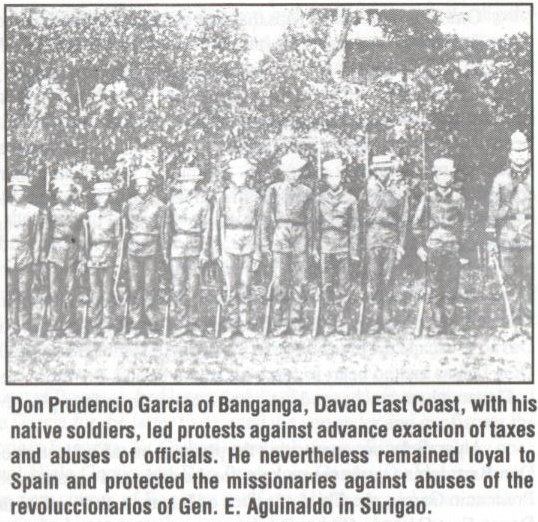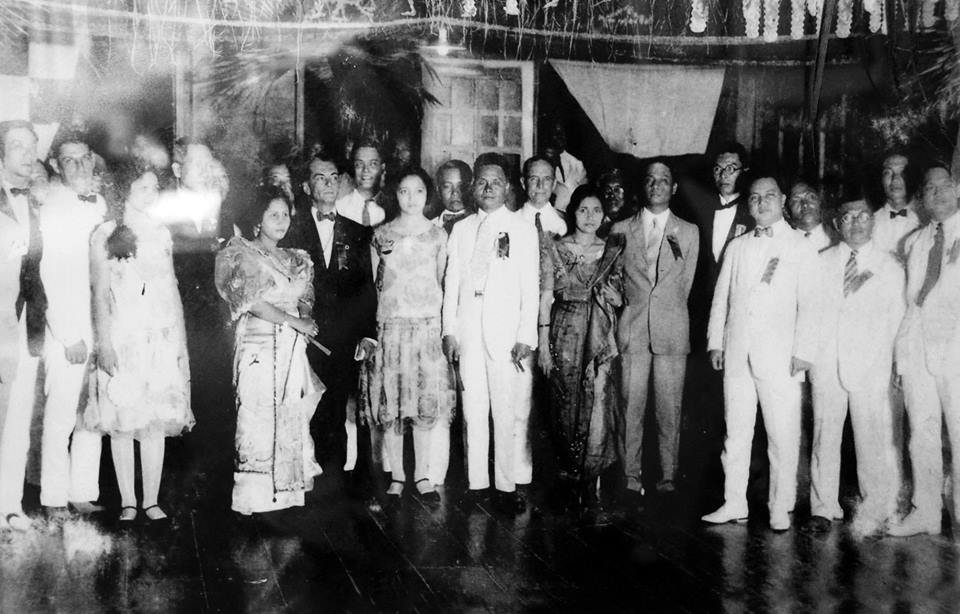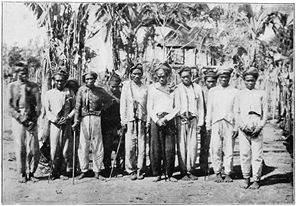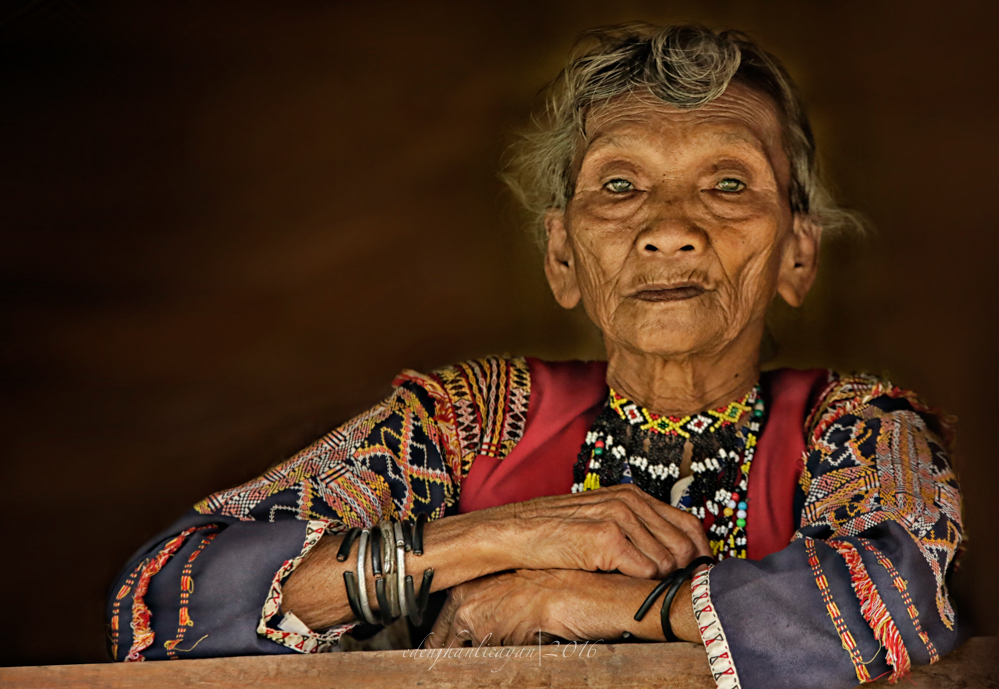
Experience Davao Oriental
History of Davao Oriental
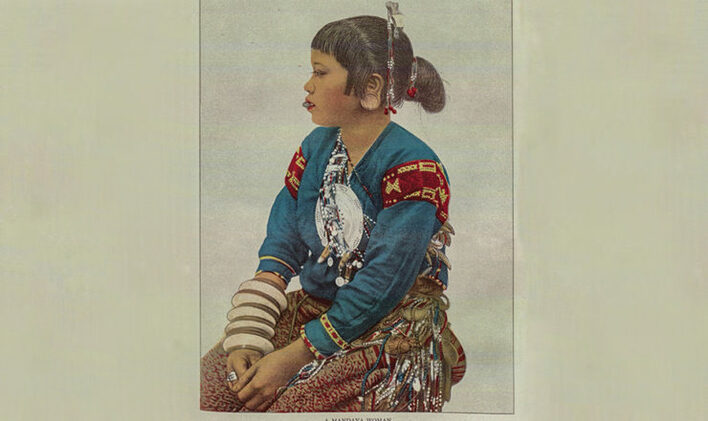
The Pre-Spanish Era
The pre-Spanish era of Davao Oriental, that is before 1521, is marked by a very primitive way of life, worship, culture, customs and traditions. Davao Oriental is populated by the Indigenous people since time past before the coming of the Muslims and the Christian Spaniards.
They were known as Mandaya, Mansaka, Mamanua, Manobo, Mangguangan, Tagacaulo and Kalagan or Kagan. They were situated near the shores of the Pacific Ocean, some near the rivers, while others were in the forests. The river basin became their center of transportation. Some build their houses up the trees for security reasons from the enemies due to the bagani system of governance. Their cycle of survival/sustenance is dependent on a very primitive agriculture, fishing, and most probably a little amount of barter trade, if there was any. Their cycle of worship is centered on diwata system. Among themselves were singled out gifted women of good standing in the community, and they were chosen as balyans (the dancing priestesses) and the catalunans (the singing priestesses). From here on, we can draw an observation that LUMADs were paternalistic (of masculine influence) when it comes to governance [with the mention of bagani, datu,, rajah, etc] while the LUMADs were maternalistic (of feminine influence) when it comes to worship [with the mention of priestesses like the balyans and the catalunans].
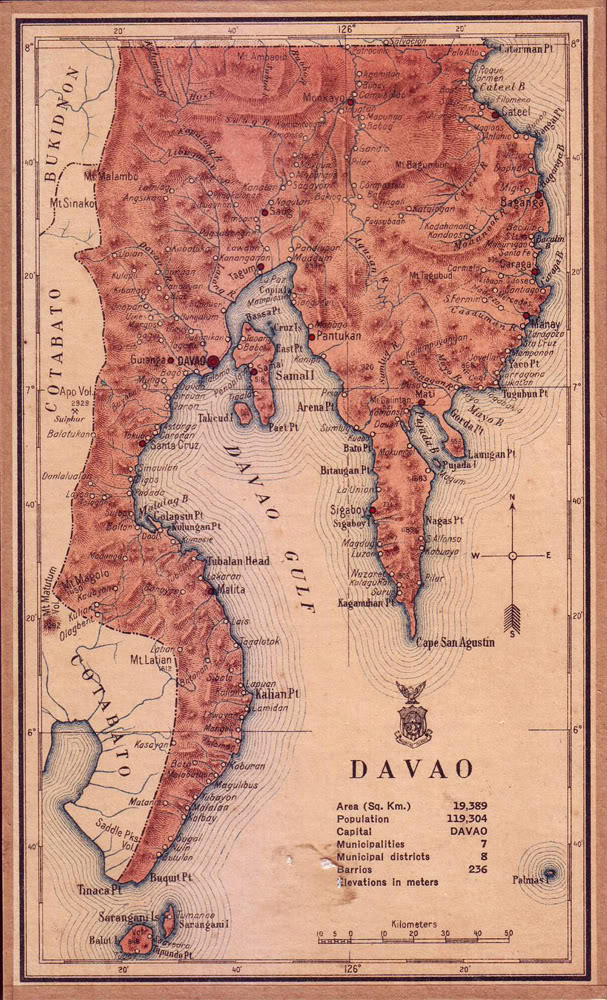
The Mandayas are close to nature. In fact, they worship close to nature, for their love of the Mother Earth. Their primitive agriculture is based on “kaingin”. and, characterized by a nomadic attributes, they transferred from one place to the other, looking for the best soil for planting. Most men of the tribes were also indulging in hunting called “pangayam”.
Returning home, they are happy to share whatever hunt they gathered for they are generous with one another. In the LUMAD community, everybody has something to share and to offer. They make their clothing from the abaca fiber called “dagmay”. They have rituals to follow from the gathering of materials up to the weaving time. Only skilled persons are gifted in the dagmay weaving. They have their own dance, music, musical instruments, ornamentals, and system of marriage rituals. In general, the whole eastern Mindanao is a place of solitude, worship, and primitive way of life. The whole region of Mindanao is composed of about twenty-three to twenty five tribes. Davao Oriental Province is inhabited by about five indigenous tribes as mentioned above, like the mandaya, mansaka, manubo, tagacaulo, calagan.
There is a tri-pod of the faith of the Mandayas: God (called the Tagallang, Magbabaya, Mansilatan), Nature, and Man.
The Mandayas believe on God and has a deep respect to nature especially the land. The land is sacred and holy. Man will die but the land remains. In principle, the Mandaya believes that land is not to be owned because man is only a steward. The Mandaya has high regards to women proven by the role of the balyans (dancing priestess) and the catalunans (singing priestess) in the community.
The LUMAD cultural dance reveals the sacredness of the land; they use barefoot in dancing to express their nearness and closeness to the land; they have a dance in moments of joy, sadness, and hatred. They chant “dawot” to retell stories of the past by oral tradition.
The challenge of the LUMAD culture to survive needs cooperation and sincere awareness and projects from the Church and the Government.
The Spanish Era
Upon the arrival of the Spaniards in AD 1521 headed by the Portuguese Conquistador Ferdinand Magellan, with his chronicler “Pigafetta”, this southeastern part of Mindanao was called “Calaghan Island”. And according to the historian Combes, its etymology comes from the word “Calag” which means “spirit or soul) therefore, “Calaghan island” is an island of “spirited” men. That’s why in the seventeenth century the whole territory of Caraga Province created in AD 1609 from Surigao to Sigaboy, was called “regio de gente animosa”, that is, “region of spirited-men”. This courageous animosity was proven by the well known “Caraga Revolt”, a native Caragans’ uprising against the moro raids and the Spanish violent denomination.
But who were the people living in these Calaghan Island? By observation, therefore, what comes immediately to our imagination, is the first inhabitants of this island who were the mandaya, mansaka, manubo, mamanua, mangguangan, tagacaulo, etc. They were called invariably as “caragans or calaghans!” At the turn of the centuries, our muslim counterparts of this island maintain and applied it as an “exclusive name” to their muslim tribe; but such was an “inclusive name” of the tribes in the very beginning.
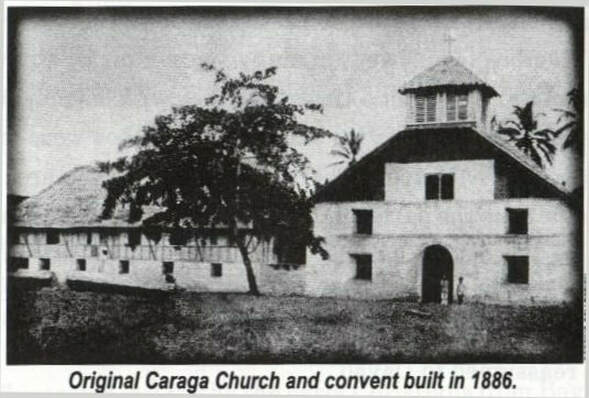
Early Spanish exploration of Davao area can be traced back to 1528 when Saavedra visited the Sarangani islands in the southwestern entrance to the Davao Gulf He coasted along the shores of Davao Oriental where he established the first settlement, that of Caraga.
The early missionaries later settled in places like Caraga, Baganga, Cateel and the nearby areas, baptizing, giving the sacraments, building churches and convents. Some of these old structures can still be found today, and some of them are still serving their Christian communities.
The missionaries from the 16th to the 19th centuries of the Philippine History, who were sent for mission to this island called “Caraga Province” in 1609 ranging from the tip of Surigao to Cape St. Augustine of Sigaboy, were the prime movers of the creation of towns and villages under the governance of the “Incomienda system”. The first of these towns which are latter called as “municipalities are: Caraga, Cateel, Baganga, Manay, Mati, Sigaboy These mentioned municipalities of Davao Oriental are called the “the centennial municipalities”.
Informal education was introduced to the natives like reading and writing, cleanliness, farming, fishing and etc. The Spaniards introduced plowing the field for agriculture’ They brought horses in this island via ships from Mexico intended for plowing the field. But the farmers preferred the carabao for plowing the field, a fruit of the natives ingenuity.
The native racial tribe Mandaya is concentrated in the whole eastcoast of Mindanao particularly the whole Davao Oriental area of the present times. The mandaya are proud of their culture and heritage. The mandayas are an honorable people, peace loving, respectful, docile, submissive and patient. Many wear their long hair. The “tigulang” is the most outstanding man in the tribe. They obey and consult him. They have legal code and penal customs. Idolatry, polygamy, and slavery are the rule among them. In age, a mandaya husband must buy his wife from the parents of the lady, serving them for period of four to six years. The spouse gives for his wife slaves, one being the minimum of this bride price. Besides the slaves, the suitor present pigs, tuba, rice, bolos and spears to the parents of the bride.
The first visayan settlers of Davao Oriental were brought forth by the spanish missionaries from the visayas who gradually intermarried with the local ethnic tribe. Once their native counterparts were converted to Christianity, they come down from the mountains to form settlements along the seacoasts known as “pueblos” or “visitas”.
In 1846, upon the order of Gov. Gen. Narciso Claveria, Don. Jose Uyanguren, led an expedition to explore regions south of the Encomienda de Bislig which was at that time under the Province of Caraga. He also organized considerable inhabitants into municipalities like Baganga, Mati and Sigaboy. Don Jose Uyanguren defeated Datu Bago, a Bagobo chieftain, at Lapanday which incident marked the end of the Datu empire. That on February 27, 1849 in recognition to Don Juan Uyanguren’s successful conquest of Davao in 1846, the same Gov. Gen. Claveria decreed the partition of Caraga Province. The northern portion was named Surigao Province with Surigao town as its capital; the southern portion was named Nueva Guipozcoa (in honor of Gov. Claveria’s natal town in Spain) with Caraga town as its capital. Nueva Guipozcoa was latter renamed Davao.
In August 31 - Sept. 3, 1924 Caraga Convention, the municipal presidents of Caraga, Cateel, Baganga, Manay, and Mati approved a resolution petitioning the higher authorities concerned to declare Eastern Davao “the contracosta” as a sub-province to be called “Plaridel”. The petition was favorably endorsed but only remains a promise of administration.
By 1945, after Second World War under the Japanese Occupation, the bigger influx of immigrants arrived in Davao Oriental. Immigration from the Visayas, Luzon and other parts of Mindanao arrived this eastern Davao area through the coming of the logging concessions and industry. Intermarriages and new forms of businesses also emerged as one of the many factors of the growing population of Davao Oriental. In the year 1956, Congressman Ismael Veloso of Davao passed a bill in Congress creating Davao Province. He proposed the separation of the municipalities of Lianga, Hinatuan, Bislig, and Lingig from Surigao Province to be combined with the contracosta towns. Unfortunately, the bill failed the approval of the Senate. He then passed another bill dividing Davao into three provinces. The bill was approved in the Lower House but failed the Senate approval. Congressman Lorenzo Sarmiento revived the bin in 1965. This time, the bill fmally passed the lower house and the senate with the help of Senator Alejandro Almendras. Then the Republic Act No. 4867 brought about the birth of the PROVINCE OF DAVAO ORIENTAL.

The Creation of the Province
From the political subdivision of Davao in 1967 emerged the provinces of Davao del Norte with Tagum as its capital, Davao del Sur with Digos as capital, and Davao Oriental with Mati as its capital.
Davao Oriental Province comprises the eastermost portion of Mindanao, of which Pusan Point of Santiago, Caraga is the eastermost vantage point of the Philippines. It covers a land area of 5,146 square kilometers….Davao Oriental survived from the hands of the elected officials of the province through the years.
The first governor of the province was the late Hon. Ponciano Bangoy from July 1, 1967 up to December 31, 1967 by virtue of the creation of the province. The late Hon. Leopoldo N. Lopez thru an election succeeded him for three years, from January 1, 1968 up to December 31, 1971. He was followed by the late Hon. Teodoro Palma Gil from January 1, 1972 to February 16, 1978 and by an election was succeeded by Hon. Francisco G. Rabat from March 1, 1978 to March 11, 1986. On March 25, 1986 as a result of the EDSA revolution, Hon. Josefina S. Sibala was appointed governor until March 19, 1987. She was succeeded by the late Hon. Leopoldo N. Lopez who was appointed governor from April 13, 1987 up to November 18, 1987. On November 24, 1987 up to January 26, 1988 the late Hon. Teodoro Palma Gil was designated officer-in-charge. On February 8, 1988 the late Hon. Leopoldo N. Lopez was again elected as governor and his untimely death ended his term on August 12, 1991. By the law of succession, Hon. Josefina C. Sibala took over the reign until June 30, 1992. Hon. Rosalind Y. Lopez who won the May 11, 1992 election took over the gubernatorial seat for three consecutive terms from July 1, 1992 to June 30, 2001. On July 1, 2001, she was succeeded by Hon. Ma. Elena T. Palma Gil who won during the May 14, 2001 election.
After a landslide victory during the May 2007 elections, Hon. Corazon T. Nuñez-Malanyaon was officially sworn in as Governor last July 1, 2007. She completes her full three-term as governor in 2016.
During the 2016 election, then Congressman of the First District of the province, Nelson L. Dayanghirang won as the next governor under the ticket of Kusog Davao Oriental.
History of the City of Mati
The term “Mati” is said to have originated from a native word “maa-ti”, which means “dries up quickly”. It was referring to a creek located in the heart of the town which was known to dry up easily even after a heavy rain. “Mati” was later associated with the entire town, not merely with the creek.
Mati as a community settlement was recorded to have been founded in 1861 by two intrepid and strong political leaders: Prudencio Garcia and Juan Nazareno who came from the east coast where they are also acknowledged as the builders of Baganga and Cateel.
Originally peopled by the Mandaya and Kalagan, Mati expanded due to migration. A very familiar name among the settlers is Don Luis Rabat who was known to be the first head of the politico-military established in this part of Mindanao.
The settlement of Mati became a regular Municipality together with Davao, Cateel, Baganga, and Caraga on October 29, 1903 by virtue of Act. No.21 of the Organic Law. Sixty years later it became the capital town of Davao Oriental. Its first appointed Mayor was Francisco Rojas and Mr. Patricio Cunanan was the first Mayor to be elected in 1923. On March 24, 2007, R.A. 9408 made Mati a city with 26 barangays. This was ratified thru a plebiscite on June 18, 2007
(Source: Provincial Tourism Office)
History of Boston
According to the old folks, Boston got its name from an American Missionary who came to the town and asked the name of the place from an old man holding a cane. The old man thinking of the cane he was holding replied “BASTON“, the corresponding vernacular. Since then, the place was called “Boston”.
Boston was a part of the Municipality of Cateel until it became an independent municipality by virtue of RA 5820 enacted on June 21, 1969. Its organizational existence commenced in 1971 when the first set of municipal officials took their oath of office on January 1, 1971. Honorio Cabrera Yucosing was the appointed Mayor whose four (4) year term of office was extended. In January 1977, he tendered his resignation but was replacefd only on October 4, 1977 upon assumption to office by Hon. Vicente R. Castillones who further served as elected Municipal Mayor from 1980 until 1986. After the EDSA Manuel Rodriguez Castro was appointed OIC Mayor and was later elected Mayor in 1988 for one term until 1992 when he lost the seat to then Vice Mayor Rebecco Butulan Rosit, Sr. Mayor Rebecco B. Rosit served for a maximum of three (3) terms from 1992 until 2001 when his brother Ramie B. Rosit took the mayoral post for another three electoral terms until 2010 when Mayor Rebecco B. Rosit, Sr., again assumed the position.
History of Caraga
Caraga, the oldest town of Davao Oriental, is said to have derived its name from a native word “Kalag” which means “spirit or soul”. Hence, the whole Provincia de Caraga of AD 1622 was called “regio de gente animosa”, that is, “region of spirited men” and the people living there were called caragans or calaghans.
Historical records attest that Caraga was listed as an encomienda belonging to Juan Gutierrez del Real and Francisco dela Cruz in 1591 in the Provincia de Caraga. As such, in the whole history of the Christianization of Mindanao, Caraga is widely known as the oldest mission.
As early as 1835, baptismal and marriage registers recorded the sacramentalization in Caraga. However it was only in 1877 that formal evangelization of Caraga into a Parish venue began in the hands of Fr. Pablo Pastell, SJ. The Church and convento of the Mision de Caraga was completed in 1883 which also dates the creation of the Parish. The first parish fiesta was celebrated on 1884. The San Salvador Parish of Caraga later would be named “The Triumph of the Holy Cross Parish of Caraga but with the arrival of the Maryknoll fathers “San Salvador” was reinstalled.
Caraga was created a regular municipality on October 29, 1903, by virtue of the Organic Act No. 21. The Municipality of Caraga is served by the elected and appointed Mayors and other municipal officials for almost a hundred years, excluding the civil officials of Caraga Town appointed by the Spanish authorities since creating her as a settlement under the encomienda system.
History of Cateel
Cateel was once part of the Caraga Province that was composed of four encomiendas during the Spanish period namely: Encomienda de Bislig where Cateel then belonged, Encomiendas de Surigao, Butuan and Tandag.
In 1582, the Spaniards partly explored the coast of Cateel. Landing at the mouth of the river they called it Rio de Cateel or Cateel, after they found some Mandaya (natives) splitting rattan vine. Cateel is a kind of rattan that abounds in the place.
Cateel has a long and varied history. The Spaniards took the town in 1614 and lost it to the Americans in 1900. It became a regular Municipality during the American regime by virtue of Organic Act No. 21 passed by the Legislative Council of the Moro Province on October 29, 1903.
History of Manay
One bright morning in 1860, three sisters were bathing and washing their clothes in the Manay river when they noticed a galleon with Spanish soldiers entering river. Stricken with fear, the two elder sisters scurried leaving behind their youngest sibling who was shouting Manay! Manay! (Manay is a respectful address for an elder sister or woman.) Being the first word heard by the Spaniards they therefore called the place, Manay.
Inhabited then by Mansaka and Mandaya, Manay was an old mission, being a barrio of the town of Caraga. In 1895, several residents of Manay: petitioned the Spanish Commandant in Mati for the creation of the new municipality. In September 12, 1897 the same petitioners submitted anew their petition not only for a separate township but also for a separate parish considering that they already had the necessary infrastructure namely: tribunal (administration Building), school , church, convent etc.
So the barrio of Manay was made a municipality by virtue of the Administrative Code of the Department of Mindanao in Sulu, out of the barrios of Central, San isidro, Concepcion, San Fermin, Manreza, and Santa Maria (Zaragoza) from Caraga, and the barrios of Santa Cruz, San Ignacio from Mati. In 1964 the sitios of Cayawan, Del Pilar and Rizal metamorphosed into regular barrios; Guza, Capasnan and Taocanga in 1968, Mabini and Old Macopa in 1969. In 1983, Lambog was added.
History of Tarragona
“Tarragona” is not a native word. According to old folks, a Spanish missionary who travelled doing his mission from Caraga Parish named Tarragona after his hometown in Spain. Succeeding missionaries carried also the name Tarragona.
On June 18, 1966, this former barrio of Mati, was made a municipality by Republic Act 4755 covering the barrios of Tarragona, Tubaon, Ompao, Limot and Tagabakid, all of Mati. In addition the barrios of Cabagayan, Jovellar, Maganda and Tomoaong were created. However, on June 21, 1969, Republic Act 5925 amended R.A. 4755 returning Barrio Tagabakid to Mati and adding Barrio Dadong from Manay to Tarragona.
Alfredo Abayon, Sr., was appointed by the province as Officer-In-Charge of the new municipality. In 1966, Alejandro Soliven won the first election as mayor. He held his position for two terms and was succeeded by Rogelio Enriquez. His term was cut after the EDSA Revolution when Jesus Espinosa was installed as OIC Mayor but later he was reelected for three terms after which his wife, Aurora was elected for one term. Thereafter, brothers Samuel and Nestor Uy took the helm of the municipality.
History of Banaybanay
A legend tells that in the beginning, ten families settled in a plain of untouched forest, tilled the land and planted corn and other crops. The corn vigorously grew with robust stalks with sizeable cobs (banay) yielding bountiful harvest. Thus, the place got its name Banaybanay, pertaining to the bunch of hearty corn (banay) raised by the families (banay).
Originally a barrio of the municipality of Lupon, Banaybanay became a separate municipality on June 21, 1969 with the passage of R.A. 5747 originally filed by Congressman Lorenzo Sarmiento of Davao and revived by Congressman Constancio B. Maglana.
In the November 1970 local election, Mayor Ricardo A Villanueva became the first Mayor of Banaybanay. He held the post up to June 30, 1992. He was replaced by Atty. Pedro T. Mejos who served for three consecutive terms from 1992 to 2001 and another three consecutive terms from 2004 to 2013 after Ms. Eva T. Geollegue served as Mayor from 2001 to 2004.
History of Governor Generoso
Sigaboy, the original name of Governor Generoso, comes from two words: “Siga” and “baboy”. Legend has it that one day, the settlers saw in the little islet of Sigaboy an apparition of Saint’ Elmo’s fire called by the natives as “siga” with the presence of the pig called “baboy”. When asked as to where this first apparition occurred, they pointed fingers to that small islet fronting Barrio Tibanban, and mumbled words like “Sigaboy!” Since then, the whole area was called Sigaboy by both settlers and passers-by.
When the Spaniards arrived, Sigaboy, originally settled by the Manobo and Tagacaulo tribes, experienced being visited by the some European colonizers especially in the area called Cape St. Agustin as it was so important for strategic navigational demarcation being at the tip of the south-eastern part of “Provincia de Caraga”. Common tradition says that around 1550, St. Francis Xavier was known to have anchored at Sigaboy particularly at the Cape St. Agustin and even celebrated the Holy Eucharist on the stones of the Cape whose cathedral-like façade they named “Altar” [n.b., until now the inhabitants call it that name]. In fact, the patron saint of Sigaboy, St. Francis Xavier was attributed to that personal presence of the saint in Sigaboy.
On February 22, 1921 the Governor General of the Philippines, Francis B, Harrison issued an Executive Order No. 8 creating the Municipal District of Sigaboy, On August 1, 1948, two years after the creation of the Republic of the Philippines, President Elpidio Quirino issued an Executive Order No. 156, Series of 1948, creating the Municipality of Governor Generoso (Sigaboy) in honor of the late Governor Sebastian Generoso of Davao. He was a son of Sigaboy. President Quirino appointed his brother Ramon Generoso the Municipal President of Sigaboy.
The local election of 1950 installed Catalino Sajulla as the first elected mayor of Governor Generoso. After the creation of the Province of Davao Oriental in July 1, 1967, Paterno Atencio became the second elected mayor. He was followed in 1980 by Felixberto C. Catada, Sr. After the EDSA revolution the transition of governance made Mayor Catada vacate his post for another appointed Office-In-Charge Mayor of the municipality to come in.1986 to 1988 were years of political instability for the municipality of Governor Generoso when several appointments for the OIC Mayor’s office. Felixberto C. Catada was re-elected mayor in the May 1988 local election. In 1992, Vicente D. Orencia won the electoral race and served as mayor for three consecutive terms until 2001 when he was replaced by Jerry V. de la Cerna. In 2007 Mayor Vicente D. Orencia regained mayorship of Gov. Generoso.
History of Lupon
Lupon derived its name from the Kalagan native word “naluponan”. This means a body of land accumulated at the mouth of a river resulting from years of continued accretion. The settlers were said to be responsible in abbreviating the word “naluponan” to what is now known as “Lupon”.
Through the successive wave of migration of Muslims and Christians, Lupon first became a regular barrio of Pantukan in 1919. After two years, by virtue of Executive Order No. 8, series of 1921, issued by Governor General Francis Burton Harrison, it became a Municipal District with eight (8) barrios under its jurisdiction, including the barrio of Banaybanay. Datu Commara Manuel served the Presidential Chair for nine (9) years. About the same time, Lupon was made a Muslim sultanate with Datu Commara Manuel crowned as Sultan. On August 8, 1948, Lupon was finally elevated into a regular municipality based on an executive order issued by then President Elpidio Quirino who appointed Teodoro Panuncialman as its first Municipal Mayor.
History of San Isidro
The municipality of San Isidro whose name was derived from its patron saint San Isidro Labrador owed its creation to the dream of the late Honorable Vicente Yu, Sr., the acknowledged father of the municipality, who was then the Vice Mayor of Gov. Generoso. He lobbied in Congress for the creation of a new municipality out of Gov. Generoso, hence, the passage of House Bill No. 661 authored by Congressman Ismael S. Veloso. The bill was approved by the House of Representatives but failed to make it to the Upper House. Hon. Lorenzo S. Sarmiento filed again the same proposal through House Bill No. 387, which reached the House of Senate on October 9, 1965.
President Diosdado Macapagal signed Executive Order No. 182 titled “Creating the municipality of San Isidro in the Province of Davao”. The Senate and the House of Representatives approved Republic Act No. 4744 on June 18, 1966 ordering the creation of the municipality of San Isidro. However, it started operating as a fifth class municipality only on January, 1968 after a local election that had Vicente Yu, Sr. elected as the first municipal Mayor. Succeedng mayors, in chronological order are: Feliciano S. Yu, Sr., Alfredo B. Leones, Luis Megriño as OIC after the EDSA revolution. Alfredo B. Leones, Justina MB. Yu, Apolinar Q. Ruelo, Sr. and Edgar Flor Saulon.

